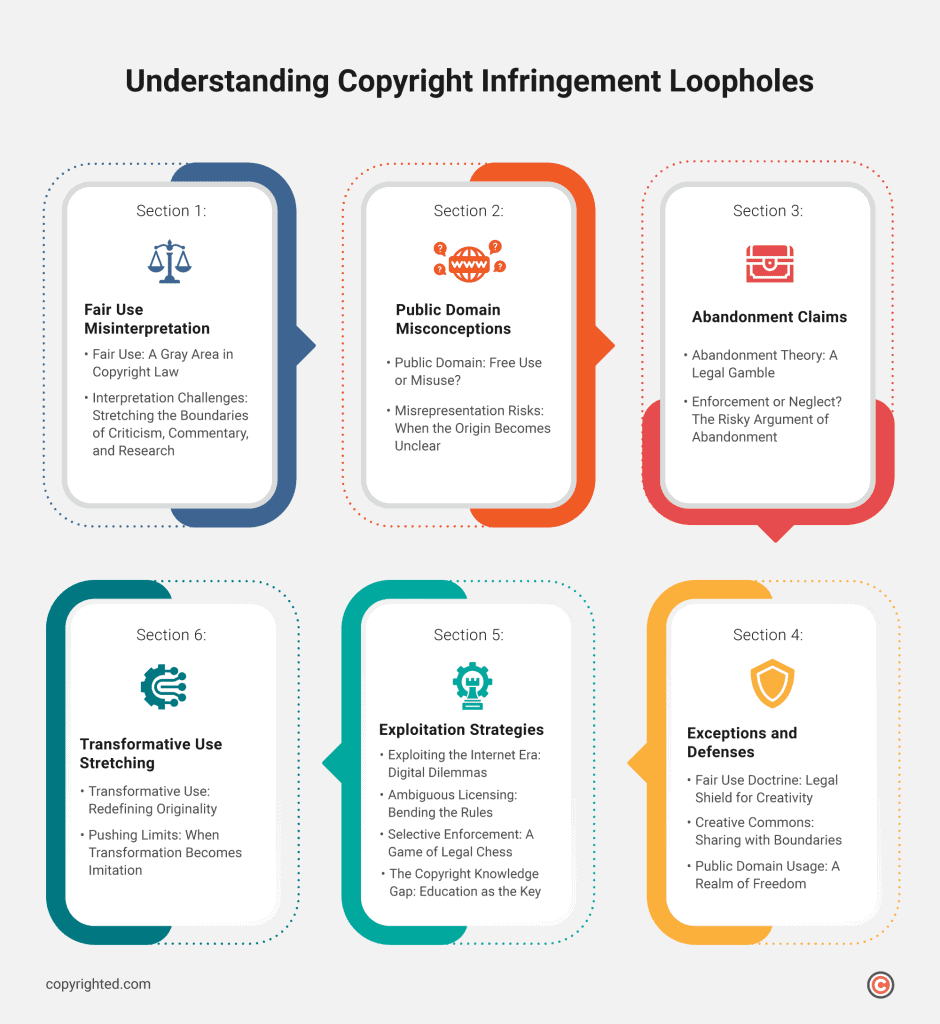Copyright laws serve as the bedrock of protecting intellectual property. However, some individuals or entities may attempt to exploit perceived loopholes to circumvent these laws, making it a complex challenge to protect intellectual property rights.
Let’s examine how these copyright infringement loopholes work, the strategies used to exploit them, and the possible consequences for creators and their work.
- Copyright infringement loopholes are strategies or misinterpretations that people use to exploit weaknesses in copyright laws, letting them use copyrighted material without proper permission or facing legal consequences.
- Fair use, a critical component of copyright law, can be manipulated, leading to potential exploitation as a loophole.
- Copyright holders actively pursue legal action against individuals exploiting loopholes to protect their intellectual property rights.
Table of Contents
What are the Copyright Infringement Loopholes?

Copyright infringement loopholes are strategies or misinterpretations that people use to exploit weaknesses in copyright laws, letting them use copyrighted material without proper permission or facing legal consequences.
Discovering copyright loopholes can be surprising, but knowing what legal consequences may follow is vital. Intellectual property protection is complex, and exploiting these loopholes means treading carefully between legality and infringement.
Let’s talk about these potential loopholes in detail.
Fair Use Misinterpretation
Fair use is a critical component of copyright law, providing a reasonable allowance for the limited use of copyrighted material without explicit permission in specific contexts. While the intentions behind fair use are noble, its interpretation introduces a considerable gray area.
The subjectivity in determining what qualifies as fair use creates an opening for individuals or entities to misinterpret and, in some cases, manipulate the doctrine to justify the unauthorized use of a copyrighted work.
For instance, while clear in principle, the broad categories of criticism, commentary, news reporting, teaching, scholarship, and research may be stretched or selectively interpreted to suit the user’s agenda. This flexibility makes it challenging to establish clear boundaries, allowing for the potential exploitation of fair use as a loophole in copyright infringement cases.
In fact, confusion around what is not considered copyright infringement, such as proper application of fair use or using works that are truly in the public domain, can further blur the line between legal use and infringement.
Public Domain Misconceptions
Being free from copyright protection works in the public domain provides a valuable resource for creative endeavors.
However, public domain misconceptions become a potential loophole when someone deliberately misrepresents a work’s status. Such misrepresentations can occur due to ignorance, negligence, or, in some instances, a deliberate attempt to capitalize on the lack of copyright protection.
Confusion may occur, especially with older works or those of unclear origin. The risk of unauthorized use increases when misunderstandings about a work’s public domain status occur.
Abandonment Claims
The notion of abandonment in copyright law introduces a risky proposition for those seeking to exploit potential loopholes. Some may argue that copyright holders have effectively abandoned their rights if they do not actively enforce them.
However, the concept of abandonment is far from straightforward and lacks a universal definition within copyright statutes. Attempting to claim abandonment as a defense against copyright infringement allegations requires careful consideration of specific legal criteria, and success is not guaranteed.
Transformative Use Stretching
The transformative use doctrine permits the use of creative work if it is substantially altered from the original. While this doctrine is essential for encouraging new forms of expression, there is a risk of stretching the definition of transformative use beyond its intended scope.
The challenge lies in determining the extent of transformation required for a work to qualify as transformative.
Taking advantage of this uncertainty, some people may push the limits to justify actions that seem like copying or infringing. Stretching the idea of transformative use can lead to legal issues, highlighting the importance of understanding the doctrine’s intended purpose in detail.
How Do Individuals or Businesses Typically Exploit Copyright Infringement Loopholes?
Unpacking how these loopholes are utilized provides significant insights into individuals’ and businesses’ strategies to work around copyright laws. Here are some of them:
Exploiting the Internet Era
In the modern digital era, businesses use the internet to share original work without proper permission, making exploitation of online platforms widespread and content distributed much faster. Unauthorized sharing in the digital space contributes to large-scale copyright infringement.
This trend has also sparked growing concerns about copyright censorship, particularly when automated takedown systems mistakenly flag content that falls under fair use or other exceptions, inadvertently restricting lawful expression.
Ambiguous Licensing Tactics
Some individuals or entities may take advantage of unclear terms in licensing agreements, interpreting them to benefit themselves. This approach lets them use copyrighted material without immediate legal consequences.
By capitalizing on unclear clauses in licensing agreements, these individuals or businesses effectively bend the rules to suit their interests, often stretching the boundaries of allowed use.
Selective Enforcement Strategies
At times, copyright holders may selectively enforce their rights, causing confusion and potential loopholes for infringers. This is more noticeable when a copyright holder is seen as not being strictly enforced.
In such cases, those infringing on copyright may use inconsistent enforcement to justify their actions, creating an environment where legal boundaries become unclear.
Copyright Knowledge Gap
Problems often come from not knowing enough about copyright laws. People or organizations might use copyrighted material wrongly because they don’t know much about intellectual property rights.
Fixing this lack of knowledge is essential, not just for encouraging good practices but also for making sure everyone follows copyright rules. Giving thorough education about the effects and limits of copyright law can help create a more responsible and law-abiding creative environment.
Copyright Infringement Exceptions and Defenses
In copyright law, certain exceptions and defenses help balance protecting creators and encouraging creativity, education, and innovation. Let’s look at three important aspects.
Fair Use Doctrine
The Fair Use Doctrine is an essential defense, allowing the limited use of copyrighted material for certain purposes. While it can be manipulated, fair use is a valid defense when the use is for criticism, commentary, news reporting, teaching, scholarship, or research.
This doctrine recognizes the need to balance the rights of copyright holders with the importance of allowing free expression and creative exploration.
Creative Commons Licensing
Some creators choose Creative Commons licenses, a collaborative method permitting specific uses of their work under set conditions.
Following these licenses establishes a legal structure for using copyrighted material within the defined limits. It presents a flexible alternative to traditional copyright, encouraging a culture of shared creativity while allowing creators control over how their work is used.
Public Domain Usage
Works in the public domain offer creative freedom, as copyright restrictions do not bind them. However, understanding and accurately determining a work’s copyright status before use is essential.
This ensures that creators and users can freely and responsibly leverage works in the public domain without legal constraints, contributing to a diverse and open creative landscape. These exceptions and defenses in copyright law try to strike a balance.
They recognize creators’ rights while promoting a culture that supports creativity, education, and innovation. It’s a careful interaction meant to protect creators’ interests in the ever-changing world of creative expression.
Frequently Asked Questions
Can unintentional copyright infringement loopholes still result in legal consequences?
Yes, unintentional exploitation of copyright infringement loopholes can lead to legal consequences.
Are there international differences in copyright infringement loopholes, or are they uniform globally?
Copyright infringement loopholes may vary internationally, with different laws and regulations across countries.
How do fair use and fair dealing provisions contribute to copyright law, and do they create loopholes?
Fair use and fair dealing provisions allow limited use of copyrighted material for specific purposes, contributing to a balanced copyright system. However, they can be manipulated, potentially creating loopholes.
Do copyright holders actively pursue legal action against individuals exploiting loopholes?
Yes, copyright holders often pursue legal action against those exploiting loopholes to protect their intellectual property rights.
How do you get out of copyright infringement?
Getting out of copyright infringement involves understanding and adhering to copyright laws, obtaining proper permissions, or utilizing legal defenses like fair use, depending on the situation. Consulting legal professionals is advisable for accurate guidance.


